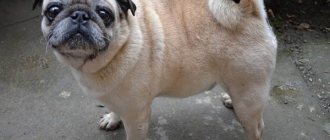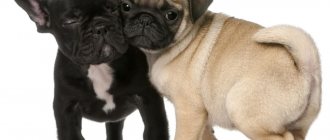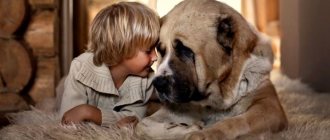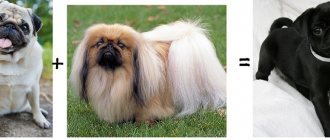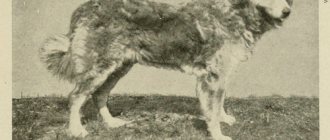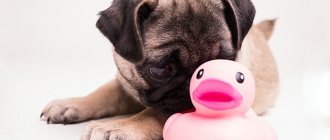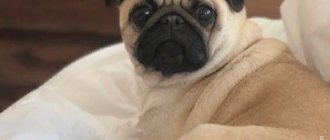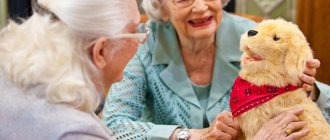02/06/2019 Drozd Nikolaevich Animals 1 There are different dogs. Big and small, serious and funny. And some are absolutely wonderful. Small plush creatures that are distinguished by a great mood, cheerful disposition and inexhaustible energy. Today we will talk about pugs. The history of the origin of the breed and some of the characteristics of these dogs will help you make the right choice and find a pet that is truly yours in spirit.
Short story
Pugs have ancient origins. Tibet is considered the birthplace of the breed. The ancestors of pugs (Sichuan fu dogs) lived in monasteries. Tibetan monks called them “Buddha's heavenly lions” and believed that these dogs brought happiness, health and longevity.
Over time, pugs began to be introduced into the palaces of Chinese emperors. The breeding of pugs was carried out by a person close to the emperor - Chanqian. Dogs were involved in the entertainment of the imperial family - holidays, travel and hunting. Dogs were given special honors, and sometimes they were assigned servants.
During the period from 207 BC–220 AD. Pugs have spread to almost all Asian countries. From the 10th to the beginning of the 20th century, this breed was called Lao Tse (a symbol of fame and wealth). In some sources - Lo-Tse.
Lao-Tse came to Europe at the end of the 16th century, and there the breed received its final name - pug.
The first pugs were brought to Russia in the 19th century. Their original appearance and affectionate, friendly character gradually earned them universal love all over the world.
NOTE!
In Holland, a dog of this breed is usually called “Chinese Mastiff”, in France – “Carlin”, in England – “Pug”.
Ancestors of pugs
As has already become clear, the breed originated in China and gained great popularity at the court of the emperor, and then throughout the nobility. They are also mentioned in the treatises of Confucius. He described small, flat-faced dogs that were created around 400 BC. e. There are surviving images of animals wearing collars with bells. The history of the pug breed has experienced peaks of glory and oblivion, like many others.
As far as one can judge, its unprecedented popularity dates back to the 17th century. At this time, images of the ancestors of modern pugs appear on engravings and figurines, many of which have survived to this day. In those days, dogs did not yet have such deep wrinkles as modern dogs. But the drawing was already clearly visible. Experts believe that from the 16th century they can be considered fully developed dogs, although the history of the pug breed begins long before that.
Around the 16th and 17th centuries, these pets became favorites of women from high society. It was considered good form to keep this creature at home with a cute face that resembles an exotic monkey and sets off the beauty of the owner. They warmed the owner in her chambers, so they were called boudoir dogs.
Pugs character
The distinctive features of the breed are its friendly nature and calm temperament. Pugs are equally suitable for owners with no experience of keeping dogs as well as experienced owners.
Pugs get along easily with everyone and get along with other pets without problems. They are great for elderly people and families with children. Children can find a devoted, caring and loving friend in this dog.
One of the advantages of this breed is its constant readiness for tactile contact. Pugs are not demanding, patient, sociable, kind and affectionate dogs. They are devoted to their owner until the end of their days.
Despite the fact that they are not very active and like to take a nap, from time to time they have bursts of activity, then they require games and attention from the owner.
Training pugs is easy, as they are quite smart and quick-witted dogs, although some individuals can exhibit such an unpleasant trait as stubbornness.
In an apartment, pugs are attentive and vigilant; they prefer to follow their owner from room to room. When starting this breed, you should take into account that pugs do not like loneliness and do not tolerate it well when their owner does not have free time for them.
IMPORTANT!
Light-colored puppies have a calmer and more balanced temperament than black-colored puppies. Elderly and inactive people are recommended to get pugs in light shades (for example, beige or peach).
Pugs in world history
These dogs have been living next to humans for so long that many events in which they figured have accumulated. Stories about the pug dog breed can be listed endlessly, but we will try to limit ourselves to only the most interesting:
- Puppies were distributed only in the circles of the nobility. An ordinary person could not have such a dog. Soon they began to appear in large monasteries.
- Emperor Ling placed female pugs in the same important position as his wives. They could move around all the chambers, and they were fed with the best meat.
- Around 1250, Marco Polo, while traveling in the East, became one of the first Europeans to see pugs on display.
- A couple of centuries later they began to be delivered to Holland.
- There is a version that during the assassination attempt on the Dutch king, he was awakened by a devoted pug. The breed has since become the official dog of the House of Orange.
Breed standard
Characteristics of the breed accepted by the standard:
- physique - a square, stocky dog of proportional shape, compact format, with developed muscles, not fat. Pugs are medium-sized dogs. An adult male weighs 6-10 kg with a height of 30 to 36 cm, and an adult girl weighs from 6 to 8 kg with a height of 25-30 cm;
- The head is large, massive, round. The muzzle is blunt, square, short. Wrinkles are pronounced, deep;
- eyes - dark, large, round, shiny. The look is questioning and sad;
- ears - small, thin, soft, velvety texture. Varieties of ears - “rose” and “button”;
- mouth - tight overbite, lower jaw incisors in a straight line;
- neck - slightly curved, strong, thick;
- The body is short, powerful, wide in the chest, with pronounced ribs. The topline is straight;
- forelimbs - paws are strong, straight, of medium length, parallel to each other;
- hind limbs - paws are strong, straight, mutually parallel, of moderate length with well-defined angles;
- The lower part of the paws is not long, not round. The toes are clearly separated, the color of the claws is black;
- tail - double, tight curl;
- movements - the forelimbs move with a strong swing, the hind limbs with a strong push. The gait is characterized by rolling movements and swaying of the back of the body;
- the coat is soft, short, shiny, not fluffy;
- character - pugs are noble, well-mannered, sweet and cheerful;
- temperament - lively, friendly, balanced.
Expert opinion
Tolkachev Andrey Mikhailovich
veterinarian
The Pug is a strong-boned dog, “square”, stocky and well balanced. When purchasing, you should pay attention to the fact that the dog should look physically strong, healthy, well-built, all parts of its body should be located in proportion to each other.
History of the breed
Mostly foggy. These dogs have long been associated with the high society of the Netherlands and England, but they originate from China. Previously, they were even said to be descended from the English Bulldog, but there is convincing evidence of the presence of the breed in China long before Europeans arrived there.
The pug is considered one of the ancient breeds; experts believe that they were originally kept as companion dogs in the Chinese imperial chambers. The first mention of such dogs dates back to 400 BC, they are called “Lo Chiang Tse” or Fu.
Confucius describes dogs with short muzzles in his writings dating between 551 and 479 BC. He describes them as companions who accompanied their masters in chariots. The first emperor of China, Qin Shi Huang, destroyed many historical documents during his reign.
Including those that mentioned the history of the breed. Largely due to this, we do not know how they appeared.
There is no doubt that these dogs are close relatives of the Pekingese, with which they are quite similar. It was believed that the Chinese first bred pugs, which they then crossed with the long-haired dogs of Tibet, such as the Lhaso Apso.
However, recent genetic studies indicate that the Pekingese is ancient and descended directly from Tibetan dogs. Modern version of the origin of the breed: the breed was obtained by selecting Pekingese with short hair or by crossing with short-haired breeds.
Regardless of when and how they appeared, mere mortals could not own these dogs. Only people of noble blood and monks could support them. Over time, the name of the breed was shortened from the long "Lo Chiang Jie" to the simple "Lo Jie".
The dogs came from China to Tibet, where they became beloved among the monks of mountain monasteries. In China itself, they remained favorites of the imperial family. Thus, Emperor Ling To, who reigned from 168 to 190 BC, was equal in importance to his wives. He placed armed guards with them and fed them with choice meat and rice.
There could only be one punishment for stealing such a dog - death. A thousand years later, after him, it was common for the emperor to take them to the parade, and they walked right after the lions, a highly respected animal in China.
It is believed that the first European to become acquainted with the breed was Marco Polo, and he saw them at one of these parades.
During the era of great geographical discoveries, European sailors began to sail around the world. In the 15th century, Portuguese and Dutch merchants began trading with China.
One of them is acquired by Lo Jie, whom he calls in his own way - a pug. He brings it home to Holland, where the breed again becomes a companion of the nobility, but now European.
They become the favorite dogs of the Oran dynasty. In 1572, a male dog named Pompey raises the alarm when an assassin tries to kill his owner, William I of Orange. For this, the breed is made the official breed of the Oran dynasty.
In 1688, Willem I brought these dogs to England, where they gained unprecedented popularity, but changed their name from the Dutch Mops to the English Pug.
It was the British who gave the breed the form under which we know it today and spread it throughout Europe. These dogs were kept by the royal families of Spain, Italy, and France. They were depicted in paintings by artists, including Goya.
By 1700, it was one of the most popular breeds among the European nobility, although in England it was already beginning to give way to toy spaniels and Italian Greyhounds. Queen Victoria of England loved pugs and bred them, which led to the creation of the Kennel Club in 1873.
Before 1860, dogs were taller, leaner, and had a longer muzzle, similar to miniature American bulldogs. In 1860, French and British troops captured the Forbidden City.
They took out a huge number of trophies, including Pekingese and pugs, which had shorter legs and muzzles than European ones. They were crossed with each other, until this time they were almost exclusively black and tan or red and black tan. In 1866, black pugs were brought to Europe and became very popular.
They were kept as companions for 2,500 years. Almost every one of them is either a companion dog or a show dog. Some perform successfully in agility and obedience, but more athletic breeds are ahead of them.
Unlike other breeds, they have not experienced peaks in popularity and the population is stable, wide and widespread. So, in 2021, the breed ranked 24th in terms of the number of dogs registered in the United States.
In recent years, they have often been crossed with other breeds to create new, decorative dog breeds. So, from crossing a pug and a beagle, the puggle, a hybrid of these breeds, was born.
What are the varieties?
In addition to the classic pug, there are other varieties of this breed:
- Lo-Sze (international name - American Lo-Sze Pugg). This variety was bred by Rebecca Mons in 1989. Visually, Lo-shis are almost no different from standard pugs, but have more compact sizes. So far, this new low-growing species is only recognized in the United States;
- Mini Pugs. This species is characterized by short stature and short legs. This variety does not officially exist, but in large litters you can often find a puppy with pituitary dwarfism (a genetic disease) that will remain small forever. Dwarf pugs are more popular than their standard cousins and sell for a higher price;
- Terrier and bulldog type pug . This type of pug is the result of a genetic failure. A characteristic feature of this type is an elongated neck - longer than required by the standard. Such dogs are distinguished by their wide and powerful chest and special paw placement.
What mixtures with other breeds are there?
There are several so-called "designer breeds" created by crossing the Pug with other dog breeds:
- chops or chihuaps . Chops is the result of crossing a pug and a chihuahua. This breed variety is still under development. A distinctive feature is a disproportionately large head;
- Pug/Chinese Crested mix . This breed was created through crossbreeding. The new representative looks very original: he is bald and has small tufts on his body. Despite its rather non-standard appearance, this breed is loved by the people and is in demand;
- French pug . This breed was created by crossing a pug and a French bulldog. Such puppies are never alike. These dogs have a variety of colors - from light cream to completely black.
The photo below shows a Chihuahuas, a Chinese Crested mix and a French Pug.
Further Adventures
This is the long and very interesting history of the pug breed. How its name came about is another interesting question that does not have a clear answer. It is believed that it is made up of two Latin words - pugnus and pugnaces. The first means “fist,” which quite plausibly describes the dog’s face.
The British made a significant contribution to the development of the breed, and also continued breeding work, which allowed the dog to acquire modern features. It still remained accessible only to the highest circles of Spain, Italy, and France. Many artists depicted these dogs on their canvases.
The history of the origin of pugs is replete with famous names. There are emperors, monks, kings and queens. Around 1736, these dogs became the secret symbol of the secret society of the Order of the Pug, which was headed by the Master of Masons. Of course, the dog became one of the most beloved among the European nobility.
Napoleon's wife and Queen Victoria of England were very fond of these charming animals. They took them to bed with them and enjoyed doing them in their free moments. It should be noted that almost until the end of the 18th century, dogs were somewhat different from those familiar to us. They were taller, thinner, with longer snouts.
But the story of the appearance of the pug breed in a modern format did not end there. In 1860, French and British troops took the Chinese city during the Opium Wars. Among the loot were pugs and Pekingese dogs with shortened legs and muzzles. They also went to their new homeland, where they continued crossing with existing English pugs. Before this, the color of the breed was yellowish or fawn. But from that moment on, purely black representatives appeared.
Popular colors
There are four main types of color:
- classic black;
- beige-brown color of various tones (“fawn”);
- beige color with apricot tint (“sunlight fawn”, “apricot”);
- beige-brown color (“moonlight silver fawn”).
Features of care
When caring for a pug, it is important to take into account all the features of this breed.
Care includes four main points:
- walking the dog daily;
- comfortable living conditions;
- hygiene procedures;
- properly selected diet.
It is necessary to prepare a permanent place for the dog in the house (not hot, not cold, without drafts). Please note that pugs feel better if they sleep in the same room as their owner. The optimal bed is a compact foam mattress (preferably with removable covers).
The pug also needs:
- 2 bowls (for food and water);
- collar;
- muzzle;
- harness;
- leash;
- comb (made of metal);
- eye and fold care products.
When organizing feeding, you should remember that this breed has a tendency to obesity. Pugs should not be overfed; eating sweets and starchy foods also has a negative impact on their health.
NOTE!
Puppies under 6 months of age need to have their nails trimmed regularly to prevent malformation of their limbs.
Pugs need periodic examination, since representatives of this breed often suffer from eye diseases (inflammation of the cornea), respiratory and heart diseases, are susceptible to allergic reactions, and in rare cases, epilepsy.
More information about pug diseases can be found here.
Another important point is careful care of the folds. They must be wiped with a special alcohol-free product.
When walking, you should not overload your dogs with long distance walks and sports. This breed does not tolerate heat and cold very well. In hot weather, it is advisable to shorten the walking time; in winter, the dog can be insulated using special clothing for animals.
Today and always
For more than 2,500 years, these dogs have been bred as companions and perform excellent tasks assigned to them. The breed has a very large and constantly growing number of fans. However, recently there has been a tendency to cross them with other dogs, such as beagles. The resulting interesting creatures are known as “puggles.” While any inbreeding is a one-time litter that does not go further into reproduction, these are considered purebred dogs.
It should be noted that great popularity has a bad effect on the purity of the breed. Due to the demand for offspring, unscrupulous breeders create entire puppy mills without caring about the health of mothers and babies. The main thing is quantity. Of course, when choosing a future family member, it is better to get to know the breeder better.
What do the puppies look like?
Pug puppies look like a mini version of an adult dog.
Since a puppy is purchased at an early age, you need to be prepared for the fact that the visual appearance may change several times. Only an experienced breeder will be able to say exactly what the final color of the dog will be.
Pugs are purchased at the age of 2-3 months, at which point the dog’s bite should already be formed, all teeth should be in place, and the coat should be of a uniform color.
Pugs grow quite quickly. Dogs reach their maximum weight at approximately 10-12 months.
How to choose a pug?
The best solution is to take a dog from a special breed kennel or from a reputable breeder. The presence of documents will confirm the thoroughbred origin. It is not advisable to buy a puppy based on an advertisement in a newspaper or from a free website, since there may be individuals with any defects in the breed, as well as with an unstable psyche.
When choosing a pug, you should pay attention to the fact that there are puppies of different classes:
- show class (for participation in exhibitions and competitions);
- breeding class (middle class for breeding offspring);
- pet class (dogs that do not meet breed standards, but are suitable for home keeping).
The price of the puppy is determined according to the class. The difficulty of care also depends on the class.
When choosing a dog, you need to examine it:
- ears and eyes must be clean;
- the coat should be healthy (shiny and without bald spots);
- there should be no pimples or redness on the skin;
- the dog's nose should have a cool temperature;
- teeth – white and healthy;
- the stomach is elastic.
It is worth paying attention to the genitals. There should be no discharge, no unpleasant odor, and by the 3rd month both testicles should descend into the scrotum of a male dog.
IMPORTANT!
When choosing a dog for breeding, you need to pay attention to color, pedigree and health. It is necessary to clarify with the breeder how the puppy was born (those individuals that were born among the first are more valued), whether all the necessary vaccinations have been completed, and whether a deworming has been carried out.
And, of course, the puppy must be playful, active, sociable and socially adapted.


